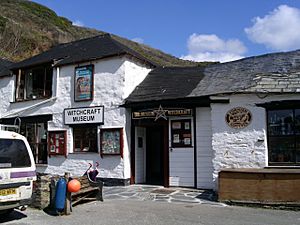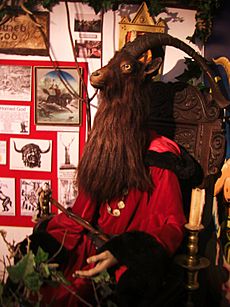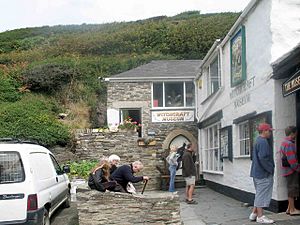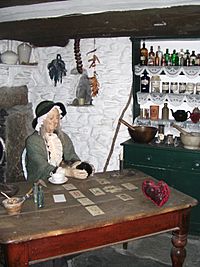Museum of Witchcraft and Magic facts for kids
 |
|
| Established | 1951 |
|---|---|
| Location | Boscastle, Cornwall |
The Museum of Witchcraft and Magic is a museum all about European witchcraft and magic. It is located in the village of Boscastle in Cornwall, England. The museum has the world's largest collection of items related to magic and witchcraft.
Inside, you can see exhibits on different kinds of magic. These include folk magic (spells and charms used by everyday people), ceremonial magic, Freemasonry, and Wicca (a modern nature-based religion).
The museum was started in 1951 by an English folk magician named Cecil Williamson. He wanted to show his personal collection of magical objects. Over the years, the museum moved several times before finding its permanent home in Boscastle in 1960.
Today, the museum is a popular place for tourists to visit. It also has a large library with books on magic and witchcraft that researchers can use.
Contents
The Museum's Magical History
An Idea is Born (1947–1951)
After World War II, a man named Cecil Williamson decided to open a museum about witchcraft. He first tried to open it in Stratford-upon-Avon in 1947, but some local people did not like the idea.
Williamson then moved his plans to the Isle of Man, an island with many old stories about fairies and witches. In 1948, he bought an old building called "the Witches' Mill" in the town of Castletown. He set up his museum there and even opened a restaurant next door called "the Witches' Kitchen."
The museum officially opened in 1951. This was the same year that the British government removed old laws against witchcraft.
The First Museum and a New Friendship
To get people interested, Williamson invited a group of witches to the museum's opening. One of these people was Gerald Gardner, who became the museum's "resident witch." Gardner was a key figure in the modern religion of Wicca. The museum's opening helped him share his beliefs with more people.
Williamson was also interested in magic himself. He studied old books to learn spells and offered to help people who thought they had been cursed. He acted much like the "cunning folk" of old England, who were village magicians that helped their neighbors.
However, Williamson and Gardner soon had a disagreement. Gardner felt that some of the museum's displays were too flashy and not serious enough. Because of their argument, Williamson sold the museum to Gardner in 1954.
A Split and Two Museums
After selling the museum on the Isle of Man, Williamson returned to England with his own collection of magical items. In 1954, he opened a new Museum of Witchcraft in Windsor. It was popular with tourists, but some locals were still unhappy with it.
Meanwhile, Gardner renamed the museum on the Isle of Man to The Museum of Magic and Witchcraft. He ran it until he passed away in 1964. After his death, the museum's collection was eventually sold to the Ripley's company.
Because of opposition in Windsor, Williamson moved his museum again in 1954 to Bourton-on-the-Water in Gloucestershire. There, the museum faced more problems, including vandalism.
Finding a Permanent Home in Boscastle (1960)
In 1960, Williamson finally found a lasting home for his collection in the quiet village of Boscastle, Cornwall. He ran the museum here for many years. He focused on displaying items related to folk magic, which he called the craft of the "wayside witch."
In 1996, at the age of 85, Williamson sold the museum to a new owner, Graham King. King was also interested in magic and witchcraft. He and Williamson completed the sale at midnight on Halloween.
New Owners and Modern Times
Graham King updated the museum's exhibits. He also arranged a proper burial in 1998 for the remains of Joan Wytte. She was a woman who had been called a witch and died in jail in 1813. Her skeleton had been at the museum for many years.
In August 2004, a major flood hit Boscastle and badly damaged the museum. Many items were swept away or ruined. The museum had to close for repairs and reopened in March 2005.
In 2013, King passed the ownership of the museum to Simon Costin. Costin is the founder of the Museum of British Folklore. He promised to keep the museum running just as it was, preserving its unique character for future visitors.
What's Inside the Museum?
The museum's exhibits show how witchcraft has been a part of history for a long time. It also shows that it is still a living practice today.
Most of the displays are about folk magic. One popular exhibit is a recreation of a "cunning woman's" cottage. It shows a mannequin of a 19th-century village magician surrounded by herbs, charms, and tools for seeing the future.
Other exhibits explore:
- The witch trials that took place in Europe hundreds of years ago.
- The modern religion of Wicca.
- Other magical traditions like ceremonial magic, Freemasonry, and alchemy.
The museum also holds special items that once belonged to famous people in the world of magic. These include a cup used by the magician Aleister Crowley and magical tools created by Gerald Gardner and Alex Sanders, another important Wiccan.
The collection is always growing. Many modern witches and magicians choose to leave their tools and magical items to the museum in their wills.
See also




